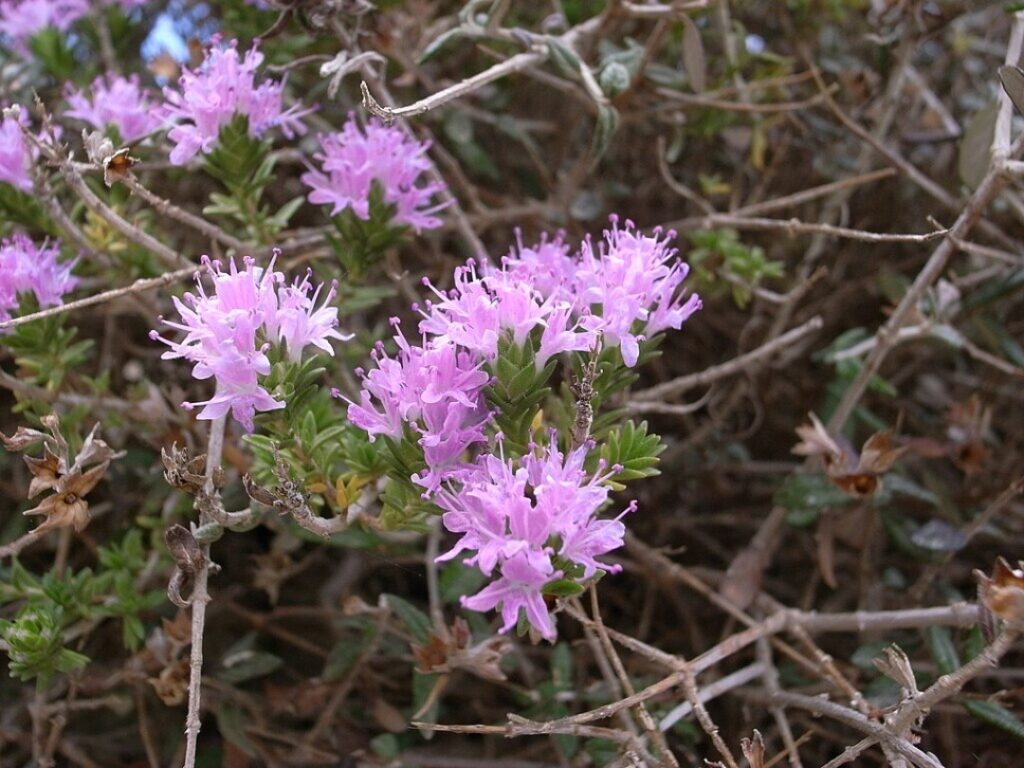
Dennis Barthell, CC BY-SA 3.0
Malta
Thyme
Thymbra capitata

General Description / Cultural Significance
The Wild Thyme of Malta can be found in cushion-like clumps along the scrublands, valleys, and rocky shores of the country’s islands. Maltese Thyme, Thymbra capitata, is a small low-lying evergreen shrub that, when in season, is covered in purple blossoms. It is a plant so beautiful that in 1932 the country had to establish a law to prevent the species from dying out because people were taking the purple flower and putting it in their homes. Thymbra capitata is found all over the garigues of Malta and is known not only for its colorful floral beauty but also for its savory smell.
The woody shrub serves as an emblem of strength. Mediterranean Thyme found in Malta has been able to withstand the impact of rising temperatures so far, and the plant often finds itself in drought conditions. It thrives in arid rocky areas and preferers poor soil. When established, it can also survive cold exposure and the strong winds of Maltese island storms. Because of its toughness, it is no surprise that thyme was used to symbolize the courage of warriors and soldiers long ago.
Malta and Thyme intertwine through the making of Wild Thyme honey. Beekeeping has a deep history in the country as the practice dates to 800 B.C. The honey, known as għasel tas-sagħtar to locals, is created in the summer when the wild thyme is one of the bees’ only nectar sources throughout the island.
Thyme shows itself to be extremely helpful plant, with uses being found in culinary, cosmetics, and medical practices. Along with its use in honey, thyme is an essential seasoning for any Mediterranean style marinade. The essential oils of Thymbra capitata produce the substance of Thymol, which has long been used for the treatment of the respiratory system. Thyme is also found in numerous perfumes, deodorants, and even in disinfectants.
Climate Change/Conservation Status
With a drought tolerance of up to five months, Maltese Thyme is very resistant, but as climate change brings forth intense heat waves and little rain, the shrub is being tested. In 2022 many beekeepers began bringing attention to the death of many wild thyme plants. While the plant does not usually die from lack of water, drought in the area is steadily reducing the available groundwater and experts believe that over the next 80 years, the groundwater in Malta will deplete by 16%.
Malta, though, is a very climate conscious country and is continuing to come up with new ways to teach and practice conservation. A new project called “Stejjer Imfewħa” which translates to “Scented Stories” aims to teach the importance of conserving herbs like thyme through culinary workshops. The group teaches conservation through ethnobotany, or how cultures use plants native to Maltese people and immigrants. The group believes that bringing traditional knowledge to people will lead to them wanting to do their part to keep their native plants, such as Thyme, alive.
Alternate Names
Wild Thyme
Mediterranean Thyme
Sources
(2011, June 17). Wonder Weed 5 – Thyme. Malta Independent. https://www.independent.com.mt/articles/2011-07-17/news/wonder-weeds-5-wild-thyme-295693/cookie-declaration.
(2012, December 23). Climate Change Chaos. Malta Independent. https://www.independent.com.mt/articles/2012-12-23/news/climate-change-chaos-572620801/.
Cutajar, J. (2016, January 29). Malta’s drinking water supply is under threat. Climate change is to blame but not only. Euronews. Retrieved June 4, 2023, from https://www.euronews.com/my-europe/2023/04/06/maltas-drinking-water-supply-is-under-threat-climate-change-is-to-blame-but-not-only#:~:text=Climate%20change%20is%20to%20blame%20but%20not%20only,-Tourists%20wear%20face&text=The%20central%20Mediterranean%20archipelago%20is,helping%2C%20experts%20have%20told%20Euronews.
Permanent Mission of Malta to the United States. This information can be found on the original World Sensorium Website.
Levikov, N. (2016, January 29). A small European island teaches conservation through its herbs and spices. Mongabay. https://news.mongabay.com/2016/01/a-small-european-island-teaches-conservation-through-its-herbs-and-spices/.

